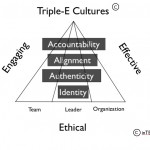Most of you have witnessed (and perhaps been victims of) disappointing or even disastrous organizational change efforts. A 2010 IBM comprehensive global study of organizational change initiatives revealed that 60% of them fail; JCP (the retailer formerly known as J.C. Penney) is the latest high profile example. Yet we live and work in times when the capacity to lead change effectively has perhaps never been greater. Let me add my perspective to the oceans of advice about leading organizational change.
First, let’s consider what the criteria for successful organizational change should be. I  propose that there are three:
propose that there are three:
- Effectiveness – changes should accomplish their desired effect.
- Engagement – changes should build the commitment and loyalty of those we hope will execute desired changes.
- Ethical – change processes and outcomes should be fair and honorable.
Definitions for “integrity” include “wholeness” and “soundness.” Leading change with integrity, then, implies considering the whole; consciously or unconsciously attending to only one of two of the “3 Es” is unsound, just as a one or two-legged stool is unsound. In my book Navigating Integrity – Transforming Business As Usual Into Business At Its Best, I outline four factors that leaders and organizations can leverage to craft effective, engaging and ethical cultures; they are the same factors to leverage for leading “integrious” “triple-e” change initiatives:
Identity – Identity includes an organization’s history, stories, core principles or values, and strategic intentions. Here are some ways that sound change initiatives can leverage Identity:
- Know the organization’s culture, including its core strengths and vulnerabilities. Build on core strengths and beware of weaknesses that will undermine change efforts.
- Tap pride in the organization and what it stands for; how will change initiatives build on founding principles or core values?
- Be clear about organizational change goals and strategic direction; communicate, communicate, communicate.
Authenticity – Authenticity is about “trueness,” truth-telling and transparency.
- Be true to an organization’s foundational purpose and values. Universities and colleges have come under fire as questions arise about whether changes serve fundamental educational goals or are just about growth and money. Comparable concerns are being raised by health care practitioners as the trend toward integrated and accountable health care organizations forces many mergers and acquisitions.
- Be real. Part of JCP’s demise is due to retail strategies that looked good in theory but had never been tested in Penney’s market. Another aspect of being real is “not biting off more than can be chewed.” As Thomas Edison said: “Vision without execution is hallucination.” Change initiatives that are too much of a stretch or unsupported by necessary resources and training are unsound.
- Model desired cultures and changes. Members are loyal to organizations and engaged with change initiatives largely to the degree that they trust leadership. Hardly anything undermines trust more than “do what I say, not what I do.” For example it’s hard to get enthusiastic about a stated need to increase efficiency when executive pay gets fatter while rank and file hours are increased or their pay decreased.
- Research reveals that change initiatives driven by small secretive groups are bound for failure. Certainly not every detail of all change initiatives can be shared; in general, however, most would benefit by erring in favor of more transparency. “Nature abhors a vacuum;” rumors abound when there is inadequate communication about change initiatives.
Alignment – To paraphrase Upton Sinclair, “It’s hard to understand something when our  pay depends on us not understanding it.” Incentives, organizational structure (or lack thereof,) training, performance appraisal and other organizational systems need to send consistent messages that are aligned with organizational intentions and change initiatives. Here are some alignment change strategies:
pay depends on us not understanding it.” Incentives, organizational structure (or lack thereof,) training, performance appraisal and other organizational systems need to send consistent messages that are aligned with organizational intentions and change initiatives. Here are some alignment change strategies:
- Form should fit function. Carefully define what purposes should be served, or criteria should be met if reorganizing; generate alternatives and evaluate each against those purposes and criteria.
- Audit talent management, compensation and other human resource management practices to determine how well they reinforce a desired culture or change initiatives.
- Successful cultures and successful change initiatives make use of what Jim Collins (From Good To Great) calls “adaptive mechanisms.” Adaptive mechanisms are vehicles for assuring that an organization stays sufficiently aligned with customers, competition, markets and the environment to adapt as needed.
Accountability – Peter Drucker helped us realize that “what gets measured gets done.” Assuming that there has been clear communication about strategic direction, desired changes and their rationale, measures should be in place to help all know if they are on course. Here are some strategies for succeeding with change initiatives by leveraging accountability:
- Start with smaller targets and celebrate little victories to build confidence and momentum.
- Integrate “The OZ Principle” (as outlined in the book by that name) where everyone has responsibility, regardless of job or function, to “see it,” (see what needs doing,) “own it” (take responsibility for getting it done,) “solve it” (identifying not just problems but solutions to those problems) and “do it” (getting it done.)
- Institute measures that reinforce what is most important paying attention to, and eliminate measures that just add clutter.
- Assure that everyone has objectives and measures relevant for them that are connected to the bigger goals and changes that you are trying to achieve.
Sustainable, “triple-e” organizational change is not the product solely of strong-willed, lone authority figures. Would-be change leaders will serve themselves, their organization and its stakeholders well by engaging those affected by change, learning from best practices and evidence-based change research, and partnering with experienced guides.
Fundamentally, change is about people. It’s people who will execute desired changes (or not) and their engagement that will drive success. In the same IBM global study on change cited above, the greatest challenge reported by executives was changing mindsets and attitudes (60%, followed by culture at 49%.) Participation, communication, trust and “encouraging the heart” practices (in Kouzes and Posner’s book by that name,) coupled with the above will go far fulfilling the promise of desired change and building an organization’s change management capacity.
There is nothing more difficult to take in hand, more perilous to conduct, or more uncertain in its success, than to take the lead in the introduction of a new order of things. – Niccolo Machiavelli
People don’t resist change. They resist being changed! – Peter Senge
All change is not growth, as all movement is not forward. – Ellen Glasgow
